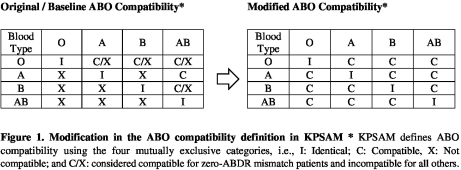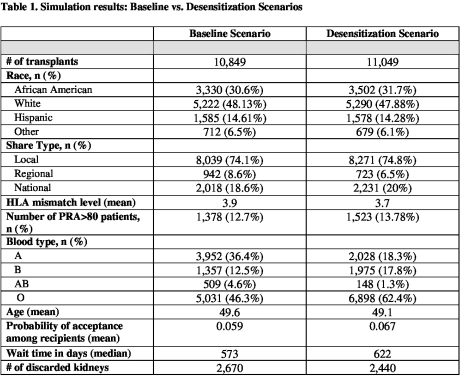ABO Incompatible Deceased Donor Kidney Transplantation – Time to Remove the Barrier
1Transplant Institute and Division of Transplant Surgery, The George Washington University Hospital, Washington, DC
2George Mason University, Washington, DC.
Meeting: 2018 American Transplant Congress
Abstract number: B118
Keywords: Allocation, HLA matching, Kidney transplantation
Session Information
Session Name: Poster Session B: Kidney Deceased Donor Allocation
Session Type: Poster Session
Date: Sunday, June 3, 2018
Session Time: 6:00pm-7:00pm
 Presentation Time: 6:00pm-7:00pm
Presentation Time: 6:00pm-7:00pm
Location: Hall 4EF
Objective: To propose a new allocation system for deceased donor kidney transplants that would decrease cold ischemia time, increase HLA matching, decrease kidney discard rates and increase kidney utilization.
Methods: A simulation analysis was performed using the Kidney-Pancreas Simulated Allocation Model [KPSAM ver. 4.1.5] to examine the consequences of implementing ABO incompatible transplants on the national registry. In order to accommodate ABO-incompatible transplants via desensitization, we modified the definition of ABO compatibility as demonstrated in Figure 1. Results: The total number of kidney transplants increased by 1.8%. The proportion of African American recipients increased from 30.6% to 31.7%. Proportion of local and national matches increased from 74.1% to 74.8% and 18.6% to 20% respectively. Proportion of HLA zero miss-matches increased from 12.97% to 15.6%. Proportion of highly sensitized recipients (PRA > 80) increased from 12.7% to 13.78%. Proportion of blood type B recipients went up while the average recipient age went down. The proportion of type O recipients went up, while type A and type AB went down. Probability of kidney acceptance went up by 13.55%. The number of discarded kidneys decreased from 2,670 to 2,440. As shown in Figure 2.
Results: The total number of kidney transplants increased by 1.8%. The proportion of African American recipients increased from 30.6% to 31.7%. Proportion of local and national matches increased from 74.1% to 74.8% and 18.6% to 20% respectively. Proportion of HLA zero miss-matches increased from 12.97% to 15.6%. Proportion of highly sensitized recipients (PRA > 80) increased from 12.7% to 13.78%. Proportion of blood type B recipients went up while the average recipient age went down. The proportion of type O recipients went up, while type A and type AB went down. Probability of kidney acceptance went up by 13.55%. The number of discarded kidneys decreased from 2,670 to 2,440. As shown in Figure 2. 
Conclusion: We posit that matching a sensitized patient to an ABO incompatible donor is more beneficial than matching to a donor to whom the patient carries donor specific antibody even at a very low level. The proposed system would introduce much more flexibility into the matching algorithm thereby allowing us to achieve more local or regional matches which could translate into having better HLA matched kidneys, reduced cold ischemia time and reduced donor kidney discards.
CITATION INFORMATION: Melancon J., Nayebpour M., Mahendran K., Spivak H., Koizumi N. ABO Incompatible Deceased Donor Kidney Transplantation – Time to Remove the Barrier Am J Transplant. 2017;17 (suppl 3).
To cite this abstract in AMA style:
Melancon J, Nayebpour M, Mahendran K, Spivak H, Koizumi N. ABO Incompatible Deceased Donor Kidney Transplantation – Time to Remove the Barrier [abstract]. https://atcmeetingabstracts.com/abstract/abo-incompatible-deceased-donor-kidney-transplantation-time-to-remove-the-barrier/. Accessed December 9, 2025.« Back to 2018 American Transplant Congress
